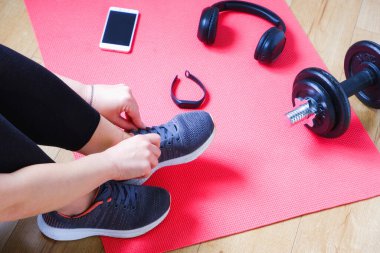
A Guide To Getting Back To Gym After Being Sick (6 Helpful Guidelines)
A guide to getting back to gym after being sick ensures a smooth transition and avoids potential setbacks. This comprehensive approach helps you rebuild strength while prioritizing your health and well-being. Getting back to the gym after being sick can feel like an uphill battle, but it doesn’t have to be daunting.
Imagine stepping back into your fitness sanctuary with renewed energy, ready to reclaim your strength and well-being. “A Guide to Getting Back to the Gym After Being Sick” is your ultimate companion in this journey, offering practical advice, motivational tips, and personalized strategies to help you transition smoothly from recovery to full fitness. Whether you’ve been out for a week or a month, this guide will empower you to listen to your body, set realistic goals, and rediscover the joy of working out, ensuring your return to the gym is not only effective but also enjoyable.

A Guide To Getting Back To Gym After Being Sick
Returning to the gym after being sick requires a gradual approach to avoid injury and ensure a full recovery. Start with light exercises, stay hydrated, and listen to your body. Consulting a healthcare professional before resuming your workout routine is advisable. Remember, patience and consistency are key to regaining your fitness levels.
Assess Your Readiness
Before diving back into your gym routine, assess your readiness. Evaluate your current health status and energy levels. If you’ve had a fever, body aches, or severe fatigue, it’s crucial to ensure these symptoms have fully resolved. Many people make the mistake of rushing back too soon, which can lead to setbacks or even a relapse. Rest is an integral part of recovery.
Start Slow and Easy
Ease back into your workouts gradually. Begin with low-intensity exercises such as walking, light jogging, or yoga. Incorporate dynamic stretches and light resistance training. The idea is to reacquaint your body with movement without overwhelming it. Pay attention to how your body responds to each session. If you experience unusual fatigue or muscle soreness, scale back.
Hydrate and Nourish
Proper hydration and nutrition are paramount when resuming workouts. After an illness, your body may be more susceptible to dehydration and nutrient deficiencies. Drink plenty of water and incorporate electrolyte-rich beverages if necessary. Focus on eating a balanced diet rich in vitamins, minerals, and protein to support recovery.
Listen to Your Body
Listening to your body is critical when getting back to the gym. Pay attention to any signs of fatigue, pain, or discomfort. If you feel overly tired or notice any recurring symptoms, it may be a sign that you’re pushing too hard. Adjust your workout intensity and duration based on how you feel each day.
Seek Professional Guidance
Consulting with a healthcare professional or a certified personal trainer can provide valuable insights tailored to your specific needs. They can help create a customized workout plan that takes into account your recent illness and current fitness level. They can also monitor your progress and make necessary adjustments to ensure a safe and effective return to fitness.
Maintain a Positive Mindset
A positive mindset is essential for a successful return to the gym. Set realistic goals and celebrate small victories along the way. Understand that recovery is a process, and it’s okay to have setbacks. Keeping a journal or tracking your workouts can help you stay focused and motivated.
Assessing Your Readiness
Getting back to the gym after being sick requires a thoughtful approach to ensure a safe and effective return to your fitness routine. First and foremost, assessing your readiness is crucial. This involves listening to your body and paying close attention to how you feel physically. If you notice signs that you’re ready to return, such as a stable energy level and the absence of fever or significant fatigue, it’s a good indicator that you might be prepared for light exercise. However, it’s equally important to recognize lingering symptoms like coughing, shortness of breath, or overall weakness, as these can suggest that your body still needs more time to heal.
Mental and emotional readiness also play a significant role in this process. Many people experience anxiety about returning to the gym, worrying about their performance or potential setbacks. Addressing these feelings by setting realistic expectations for yourself can help. Understand that it’s normal to start with a lighter routine and gradually increase intensity as your strength returns. Allowing yourself to ease back into exercise without pressure can prevent further strain and aid in a smoother recovery. Remember, the goal is to regain your fitness level safely and sustainably, rather than rushing the process and risking a relapse or injury.
Planning Your Return
Setting Realistic Goals
Getting back to the gym after being sick requires careful planning and a gradual approach to ensure both physical recovery and sustainable progress. Begin by assessing your current health status and consulting with a healthcare professional if necessary. Set realistic goals that consider your current fitness level and the duration of your illness. Distinguish between short-term goals, such as rebuilding stamina, and long-term goals, such as achieving previous fitness levels. Flexibility in your plan is crucial to accommodate fluctuations in energy levels and recovery pace.
Gradual Reintroduction to Exercise
Initiate your comeback with low-intensity workouts to gauge your body’s response. Start with light cardio or gentle stretching to ease into physical activity. Warm-ups become pivotal as they prepare muscle and joints for exercise while reducing the risk of injury. Similarly, incorporating cool-downs aids in promoting circulation and preventing post-workout stiffness.
Choosing the Right Exercises
Getting back to the gym after recovering from an illness requires a thoughtful approach to ensure a safe and effective return to fitness. First and foremost, choosing the right exercises is crucial. Opting for low-impact activities initially can help ease the body back into a routine without overstressing it. Activities such as walking, gentle cycling, or light stretching can be beneficial as they promote circulation and mobility without placing excessive strain on recovering muscles and joints.
It’s essential to listen to your body and avoid diving into high-intensity workouts right away. Pushing too hard too soon can hinder recovery and increase the risk of setbacks. Gradually increasing the intensity and duration of workouts allows for steady progress while minimizing the chances of overexertion.
Additionally, focusing on exercises that promote flexibility, core strength, and overall stability can aid in rebuilding strength and endurance gradually. Remembering to stay hydrated, get adequate rest, and consult with a healthcare professional if needed are also important steps in safely returning to a gym routine after illness. By prioritizing gentle exercises, gradual progression, and self-awareness, individuals can effectively navigate their comeback to the gym, ensuring a balanced approach to fitness and wellness.

Nutrition and Hydration
Getting back to the gym after being sick requires careful attention to nutrition and hydration to support your body’s recovery and regain strength. Nutrition plays a crucial role in replenishing lost nutrients and supporting immune function. Hydration is equally vital, helping flush out toxins and maintain optimal bodily functions. Begin by prioritizing hydration with plenty of water throughout the day. Electrolyte-rich beverages or coconut water can also help replenish lost minerals.
Incorporate foods high in antioxidants like berries, leafy greens, and nuts to boost immune function and combat inflammation. Avoid sugary drinks and processed foods that can hinder recovery. Focus on a balanced diet that includes lean proteins such as chicken, fish, or tofu to repair muscle tissue and support energy levels. Complex carbohydrates like whole grains and sweet potatoes provide sustained energy for workouts. Healthy fats from sources like avocados and olive oil aid in nutrient absorption and hormone regulation.

Building Back Your Routine
Tracking Your Progress
Getting back to the gym after recovering from an illness requires a thoughtful approach to ensure both physical recovery and mental readiness. Building back your routine gradually is essential. Start with lighter exercises and lower intensity to gauge your body’s response. It’s crucial to listen to your body’s signals and not push too hard too soon, as this could risk setbacks. Tracking your progress meticulously helps in understanding your current fitness level. Utilize a workout journal to record your workouts, including exercises, sets, reps, and how you feel during and after each session. This journal serves as a reference point to gradually increase intensity and volume as your strength and endurance improve.
Monitoring physical and mental progress is equally important. Physical progress can be tracked through metrics like weight lifted, endurance levels, and body measurements. Mental progress involves observing your mood, motivation, and overall satisfaction with your gym sessions. Recognize that it’s normal to have fluctuations in both physical and mental states during recovery. Celebrate small victories and milestones to stay motivated.
Adjusting Your Plan as Needed
Flexibility in your workout plan is crucial when recovering from illness. What worked for you before might not be appropriate immediately after your return. Listen to your body’s cues and adjust your plan accordingly. If you experience fatigue or discomfort, scale back your efforts. It’s important to remember that recovery is not a linear process; some days you may feel stronger, while other days you might need more rest. Tailoring your plan to include a variety of activities can also help. Incorporating low-impact exercises on days when you’re not feeling up to more intense workouts can keep you active without overexerting yourself. Adjusting your plan as needed ensures that you can continue to make progress without compromising your health.
Modifying the intensity and duration of your workouts is a critical aspect of returning to the gym after being sick. Start with shorter sessions, perhaps 20-30 minutes, focusing on low to moderate intensity activities. Gradually increase the duration and intensity as your body adapts and your strength returns.
For instance, if you were used to lifting heavy weights, begin with lighter weights and higher repetitions to rebuild muscle endurance before attempting to lift heavier loads. Cardio workouts should also be approached with caution; start with a brisk walk or a light jog before returning to more vigorous activities like running or high-intensity interval training (HIIT). This gradual approach helps your body to adapt and minimizes the risk of overtraining or injury. By carefully modifying the intensity and duration of your workouts, you can safely and effectively regain your pre-illness fitness levels.

Incorporating Rest Days
As you ease back into your gym routine, incorporating rest days is crucial. Your body needs time to recover and rebuild strength, especially after a period of illness. Rest days should be strategically placed throughout your week to allow muscles to repair and prevent overtraining. Listen to your body; if you feel unusually fatigued or sore, it’s a sign you may need more rest. This doesn’t mean being completely inactive on rest days; light activities like walking or yoga can promote recovery without putting additional stress on your body. By scheduling regular rest days, you not only prevent burnout but also enhance your overall performance when you are active.
Importance of Rest and Recovery
Rest and recovery are fundamental components of any fitness regimen, and this is even more important after being sick. When you exercise, especially after a break, your muscles experience micro-tears that need time to heal. Recovery periods allow these muscles to repair and grow stronger. Moreover, rest helps to prevent injuries that can occur from overuse or fatigue.
Adequate sleep, hydration, and nutrition are also vital for recovery. Sleep is when your body undergoes most of its repair processes, so aim for 7-9 hours of quality sleep each night. Hydration keeps your muscles functioning properly, and a balanced diet provides the necessary nutrients for recovery. Taking care of these aspects will ensure your body is well-equipped to handle the demands of getting back into a regular gym routine.
How to Schedule Rest Days Effectively
Scheduling rest days effectively requires understanding your body’s signals and planning your workouts accordingly. A common approach is to follow a pattern such as working out for two or three days followed by a rest day. This allows for consistent training while giving your body regular intervals of rest. Another method is to incorporate active recovery days, where you engage in low-intensity activities.
This can be particularly useful if you feel the need to move but still want to allow your muscles to recover. Additionally, paying attention to the type of exercises you do can help in scheduling rest days; alternating between different muscle groups can give specific areas more time to recover while still maintaining overall activity. Tracking your progress and how you feel can also guide you in adjusting your rest days as needed. By thoughtfully planning your rest days, you can optimize your recovery and performance, ensuring a balanced and effective return to your fitness routine.
Preventing Future Illness and Injury
Strengthening Your Immune System
Strengthening your immune system is vital to maintaining overall health and preventing future illnesses. A robust immune system can be supported through a balanced diet rich in fruits, vegetables, lean proteins, and whole grains. These foods provide essential vitamins, minerals, and antioxidants that help your body fight off infections.
Staying hydrated is also crucial, as water helps flush toxins from your body and keeps your cells functioning optimally. Adequate sleep is another critical component; during sleep, your body repairs and regenerates, and a lack of it can weaken your immune response. Stress management techniques such as meditation, deep breathing exercises, and yoga can also bolster your immune system by reducing the negative impact of stress hormones on your body.
Role of Regular Exercise
Regular exercise plays a pivotal role in maintaining a healthy immune system and preventing illness. Engaging in moderate-intensity exercise, such as brisk walking, cycling, or swimming, for at least 150 minutes per week can enhance your immune function. Exercise increases blood circulation, which allows immune cells to move more efficiently throughout your body and detect and fight infections. It also helps reduce inflammation and supports the production of anti-inflammatory substances. Moreover, regular physical activity can improve your cardiovascular health, strengthen muscles, and boost mental well-being, all of which contribute to a more resilient immune system.

Additional Tips for Boosting Immunity
In addition to regular exercise, several other practices can help boost your immunity. Incorporating probiotics into your diet through yogurt, kefir, or supplements can improve gut health, which is closely linked to immune function. Consuming foods high in vitamins C and D, such as citrus fruits and fortified dairy products, can also enhance your immune response.
Herbal supplements like echinacea, elderberry, and garlic are known for their immune-boosting properties, though it’s important to consult with a healthcare provider before starting any new supplement. Avoiding smoking and limiting alcohol intake are also crucial, as these habits can suppress your immune system. Lastly, staying connected with friends and family can reduce stress and improve your overall well-being, contributing to a stronger immune system.
Practicing Good Gym Hygiene
Cleaning Equipment
Properly cleaning gym equipment is a shared responsibility among gym-goers to maintain a safe workout space. Use antibacterial wipes or sprays available at the gym to thoroughly clean equipment before and after use. Pay special attention to high-touch areas like dumbbells, barbells, and cardio machines. Allow the disinfectant to sit on the surface for a few seconds before wiping it down to ensure maximum germ-killing effectiveness. If you notice any equipment that’s particularly dirty or neglected, inform the gym staff so they can address the issue promptly. Regular cleaning not only helps in preventing illness but also ensures the longevity and functionality of the equipment.
Personal Hygiene Practices
Adhering to personal hygiene practices is essential to protect yourself and others in the gym. Always wear clean workout clothes and change them after each session to prevent the buildup of sweat and bacteria. Shower as soon as possible after exercising to remove any germs and sweat from your body. Use a mild, antibacterial soap and dry yourself with a clean towel. Avoid sharing personal items like towels, water bottles, and gym gear to minimize the risk of cross-contamination. Keep your gym bag clean and regularly wash items such as gloves and mats. By prioritizing personal hygiene, you contribute to a healthier gym environment and safeguard your own well-being.
Injury Prevention Strategies
Proper Form and Technique
Mastering proper form and technique is crucial for both effectiveness and safety in your workouts. Each exercise has an optimal way to be performed to target the intended muscle groups while minimizing stress on joints and ligaments.
Poor form not only diminishes the effectiveness of the exercise but also increases the risk of acute injuries such as muscle tears or joint dislocations, and chronic issues like tendinitis or lower back pain. Focus on quality over quantity; performing fewer repetitions with perfect form is far more beneficial than doing many repetitions incorrectly. Utilize mirrors to monitor your posture and alignment during exercises, and don’t hesitate to ask for guidance from gym staff or hire a personal trainer for personalized instruction. Proper breathing techniques are also a part of good form; typically, exhale during exertion and inhale during relaxation phases.
Importance of Varied Workouts
Incorporating a variety of workouts into your fitness regimen is essential for overall health and preventing both physical and mental burnout. Repeating the same exercises can lead to overuse injuries and muscle imbalances. A varied workout routine challenges different muscle groups and improves overall fitness. Include a mix of cardiovascular exercises, strength training, flexibility exercises, and balance training.
For example, alternate between running, cycling, and swimming for cardio; switch between free weights, machines, and bodyweight exercises for strength training; incorporate yoga or Pilates for flexibility and core strength; and use balance boards or stability balls to enhance proprioception. This variety not only keeps workouts interesting and engaging but also ensures a well-rounded fitness level. Additionally, cross-training can help identify and correct weaknesses, making you a more resilient and well-balanced athlete.
Mental Health and Motivation
Staying Motivated
Staying motivated post-illness is a challenge many face, but with the right strategies, you can find your drive again. Start by setting small, achievable goals. Instead of diving straight into a rigorous workout, begin with light exercises that gradually build up your strength and stamina. Celebrate these small victories as they come, as each one is a step closer to regaining your full fitness. Additionally, remember the reasons why you started working out in the first place. Whether it’s to improve your health, boost your energy levels, or simply because it makes you feel good, keeping these motivations at the forefront of your mind can reignite your passion for fitness.
Setting Motivational Milestones
One effective way to stay on track is by setting motivational milestones. Break down your overall fitness goals into smaller, manageable milestones. For instance, if your aim is to run 5 miles, start with a goal of running 1 mile, then gradually increase the distance. Each milestone reached serves as a tangible achievement, giving you a sense of accomplishment and motivating you to push further. Additionally, consider setting a timeline for these milestones to add a sense of urgency and purpose to your workouts. Keeping a journal or using a fitness app to track your progress can also be incredibly motivating, as it allows you to see how far you’ve come.
Finding a Workout Buddy or Support Group
Having a workout buddy or joining a support group can significantly enhance your motivation and make the journey back to the gym more enjoyable. A workout buddy can provide encouragement, share in your successes, and hold you accountable. Choose someone who shares similar fitness goals and has a positive attitude towards exercising. Alternatively, joining a support group, whether in person or online, can provide a community of like-minded individuals who understand the challenges you’re facing. These groups can offer advice, share experiences, and provide a sense of camaraderie. Knowing that others are rooting for your success can be a powerful motivator and make the process less intimidating.
Dealing with Setbacks
Setbacks are inevitable in any fitness journey, especially after a period of illness. It’s essential to approach setbacks with a mindset geared towards learning and growth. Instead of being discouraged, view setbacks as opportunities to reassess your approach and make adjustments. Reflect on what might have contributed to the setback, whether it’s overexertion, inadequate recovery, or simply needing more time. Adjust your workout intensity or duration as needed and listen to your body’s signals.
Accepting and Learning from Setbacks
Acceptance is key to overcoming setbacks gracefully. It’s okay to feel disappointed or frustrated initially, but focus on learning from the experience rather than dwelling on negative emotions. Use setbacks as opportunities to refine your fitness strategy, whether by consulting a fitness professional for guidance, adjusting your nutrition, or exploring alternative exercises that might be more suitable during your recovery phase. Embrace the learning process and trust that each setback is a stepping stone towards greater resilience and fitness.
Strategies for Overcoming Discouragement
Overcoming discouragement involves adopting a proactive mindset and implementing strategies that foster positivity and perseverance. Surround yourself with supportive individuals who understand your journey and can offer encouragement. Set realistic and achievable short-term goals to maintain motivation and track progress effectively. Celebrate even the smallest achievements to stay motivated and reinforce your commitment to your fitness goals. Additionally, vary your workout to keep things interesting and prevent monotony, which can contribute to feelings of discouragement. Remember, consistency and patience are key to long-term success in reclaiming your fitness after illness.
Mental Health Benefits of Exercise
Incorporating mindfulness practices into gym sessions can further enhance mental resilience and focus. Mindfulness, such as deep breathing or body scans, helps in staying present during workouts, improving technique and preventing injury. Setting realistic goals and gradually increasing intensity are crucial steps towards rebuilding physical strength and endurance after illness. It’s advisable to start with light exercises and progressively increase intensity as stamina improves. This gradual approach not only prevents overexertion but also builds confidence in one’s ability to resume regular gym activities.
Creating a supportive environment at the gym also plays a pivotal role in the recovery process. Engaging with gym staff or trainers for guidance on modified workouts or personalized routines can provide reassurance and ensure exercises align with current fitness levels. Additionally, listening to one’s body and allowing adequate rest between workouts is essential for preventing setbacks and promoting sustainable progress.
Frequently Asked Questions (FAQ): A Guide To Getting Back To Gym After Being Sick
Q1. How soon can I return to the gym after being sick?
A. It’s crucial to listen to your body and ensure you’re fully recovered before resuming your workouts. Generally, if you’ve had a mild illness like a cold, you can return once your symptoms have significantly improved and you’re fever-free for at least 24-48 hours. For more severe illnesses, consult your doctor.
Q2. Should I ease back into my workout routine?
A. Yes, start with lighter exercises and shorter durations. Gradually increase the intensity and length of your workouts over a week or two to avoid overwhelming your body and to prevent relapse.
Q3. What type of exercises should I start with after an illness?
A. Begin with low-impact activities such as walking, gentle yoga, or light stretching. As your strength and stamina return, you can slowly reintroduce more intense exercises like weight lifting or cardio.
Q4. How do I know if I’m pushing myself too hard?
A. Watch for signs of fatigue, dizziness, shortness of breath, or any unusual discomfort. If you experience these symptoms, reduce the intensity or take a break. It’s important not to rush the recovery process.
Q5. Is it safe to go back to the gym if I’m still coughing or have a runny nose?
A. Mild symptoms like a residual cough or runny nose are generally okay, but ensure you practice good hygiene, such as washing your hands frequently and wiping down equipment. Avoid the gym if you’re still contagious to prevent spreading illness to others.
Q6. How can I maintain motivation during my recovery phase?
A. Set realistic, short-term goals to keep yourself motivated. Celebrate small achievements and remind yourself that gradual progress is better for your long-term health. Consider partnering with a workout buddy for additional support.
Q7. Should I adjust my diet when returning to the gym after being sick?
A. Yes, ensure you’re consuming a balanced diet rich in vitamins, minerals, and proteins to support your recovery and rebuild strength. Staying hydrated is also crucial.
Q8. How can I prevent getting sick again when I return to the gym?
A. Practice good hygiene by washing your hands frequently, using hand sanitizers, and cleaning gym equipment before and after use. Also, ensure you get adequate rest, nutrition, and manage stress to keep your immune system strong.
Q9. Is it okay to take supplements to boost my recovery?
A. Some supplements, like vitamin C, vitamin D, and zinc, can support your immune system. However, it’s best to consult with a healthcare provider before starting any new supplements to ensure they’re appropriate for you.
Q10. What should I do if I feel unwell again after resuming workouts?
A. If you start feeling unwell again, it’s important to take a step back and rest. Overexerting yourself can prolong recovery or worsen your condition. Consult a healthcare professional if symptoms persist.
Conclusion
Getting back to the gym after being sick can be a challenging yet rewarding journey. It’s important to listen to your body, start slowly, and progressively increase the intensity of your workouts. Prioritize hydration, nutrition, and adequate rest to support your recovery and enhance your performance. Consulting with a healthcare professional can provide personalized advice and ensure that your return to fitness is safe and effective. By being patient and consistent, you’ll gradually regain your strength and endurance, paving the way for a healthier, more resilient you.